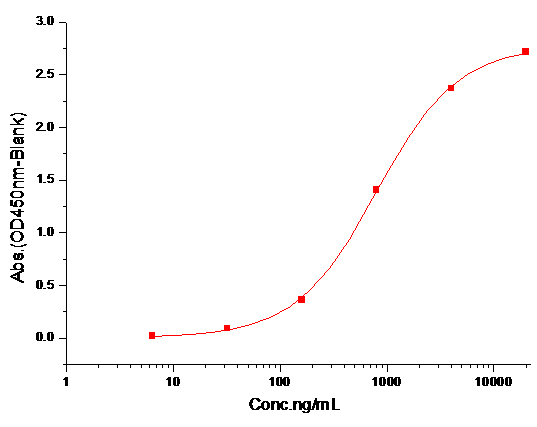Shopping Cart
- Remove All
 Your shopping cart is currently empty
Your shopping cart is currently empty

Transthyretin Protein, Human, Recombinant (His) is expressed in HEK293 mammalian cells with His tag. The predicted molecular weight is 15.2 kDa and the accession number is E9KL36.

| Pack Size | Price | Availability | Quantity |
|---|---|---|---|
| 100 μg | $588 | 7-10 days | |
| 1 mg | $3,880 | 7-10 days |
| Biological Activity | Measured by its binding ability in a functional ELISA. Immobilized recombinant human TTR-His can bind recombinant Canine RBP4-Fc with a linear range of 0.3-10.0 μg/ml.  |
| Description | Transthyretin Protein, Human, Recombinant (His) is expressed in HEK293 mammalian cells with His tag. The predicted molecular weight is 15.2 kDa and the accession number is E9KL36. |
| Species | Human |
| Expression System | HEK293 Cells |
| Tag | C-His |
| Accession Number | E9KL36 |
| Synonyms | transthyretin,TBPA,PALB,HsT2651,HEL111,CTS1,CTS |
| Construction | A DNA sequence encoding the human TTR (NP_000362.1) (Met 1-Glu 147) with a C-terminal polyhistidine tag was expressed. Predicted N terminal: Gly 21 |
| Protein Purity | > 97 % as determined by SDS-PAGE  |
| Molecular Weight | 15.2 kDa (predicted) |
| Endotoxin | < 1.0 EU/μg of the protein as determined by the LAL method. |
| Formulation | Lyophilized from a solution filtered through a 0.22 μm filter, containing PBS, pH 7.4. Typically, a mixture containing 5% to 8% trehalose, mannitol, and 0.01% Tween 80 is incorporated as a protective agent before lyophilization. |
| Reconstitution | A Certificate of Analysis (CoA) containing reconstitution instructions is included with the products. Please refer to the CoA for detailed information. |
| Stability & Storage | It is recommended to store recombinant proteins at -20°C to -80°C for future use. Lyophilized powders can be stably stored for over 12 months, while liquid products can be stored for 6-12 months at -80°C. For reconstituted protein solutions, the solution can be stored at -20°C to -80°C for at least 3 months. Please avoid multiple freeze-thaw cycles and store products in aliquots. |
| Shipping | In general, Lyophilized powders are shipping with blue ice. |
| Research Background | Prealbumin/Transthyretin, also known as ATTR, Prealbumin, TTR and PALB, is a secreted and cytoplasm protein that belongs to the Prealbumin / Transthyretin family. Prealbumin / Transthyretin is detected in serum and cerebrospinal fluid (at protein level). It is highly expressed in choroid plexus epithelial cells. It is also detected in retina pigment epithelium and liver. Each monomer of Prealbumin / Transthyretin has two 4-stranded beta sheets and the shape of a prolate ellipsoid. Antiparallel beta-sheet interactions link monomers into dimers. A short loop from each monomer forms the main dimer-dimer interaction. These two pairs of loops separate the opposed, convex beta-sheets of the dimers to form an internal channel. Prealbumin/Transthyretin is a carrier protein. It transports thyroid hormones in the plasma and cerebrospinal fluid, and also transports retinol (vitamin A) in the plasma. Defects in Prealbumin / Transthyretin are the cause of amyloidosis type 1 (AMYL1) which is a hereditary generalized amyloidosis due to Prealbumin / Transthyretin amyloid deposition. Protein fibrils can form in different tissues leading to amyloid polyneuropathies, amyloidotic cardiomyopathy, carpal tunnel syndrome, systemic senile amyloidosis. The diseases caused by mutations include amyloidotic polyneuropathy, euthyroid hyperthyroxinaemia, amyloidotic vitreous opacities, cardiomyopathy, oculoleptomeningeal amyloidosis, meningocerebrovascular amyloidosis, carpal tunnel syndrome, etc. |

Copyright © 2015-2025 TargetMol Chemicals Inc. All Rights Reserved.